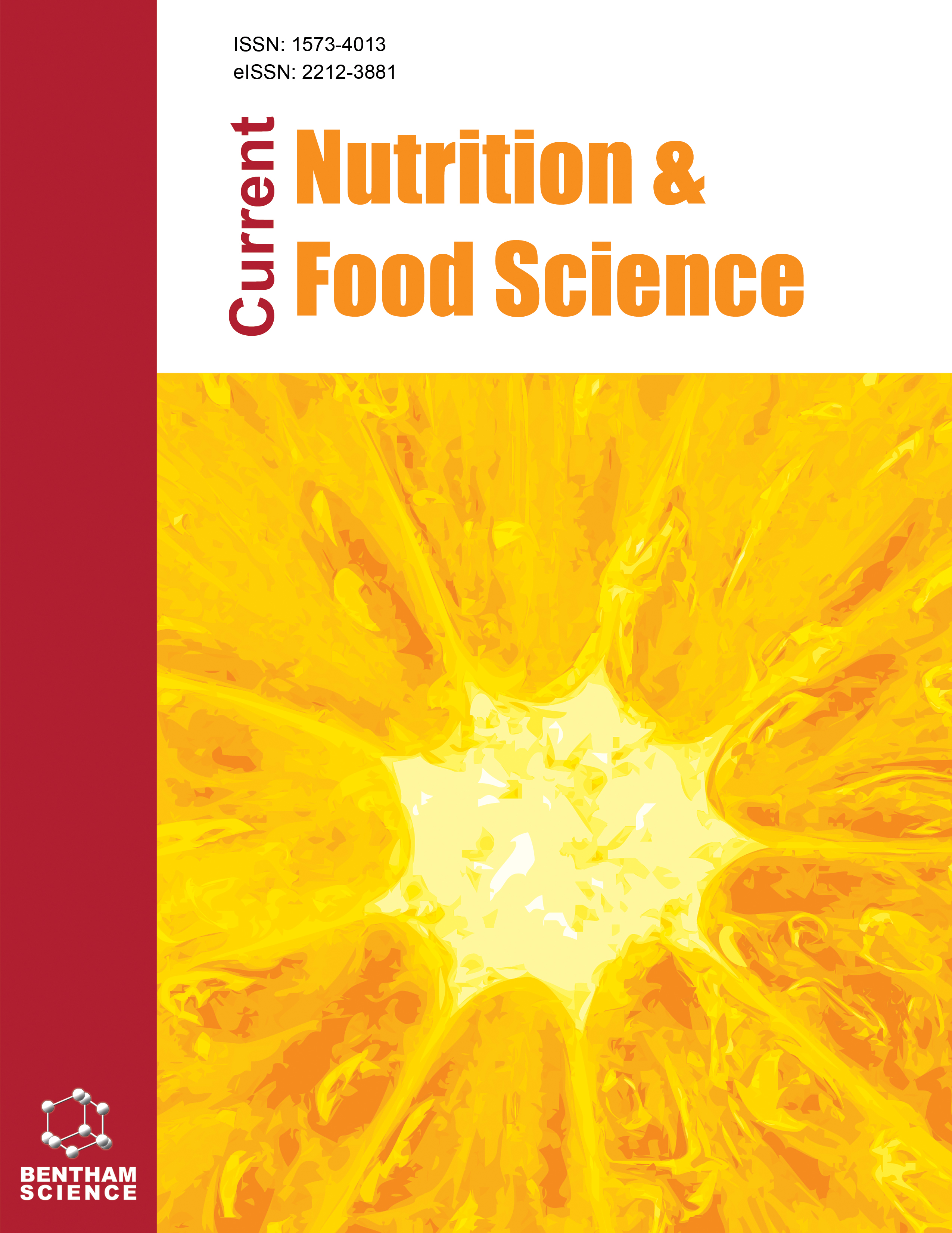- Home
- A-Z Publications
- Current Nutrition & Food Science
- Previous Issues
- Volume 5, Issue 3, 2009
Current Nutrition & Food Science - Volume 5, Issue 3, 2009
Volume 5, Issue 3, 2009
-
-
When Does Food Refusal Require Professional Intervention?
More LessFood refusal can have the potential to lead to nutritional deficiencies, which increases the risk of a variety of communicable and non-communicable diseases. Deciding when food refusal requires professional intervention is complicated by the fact that there is a natural and appropriate stage in a child’s development that is characterised by increased levels of rejection of both previously accepted and novel food items. Therefore, c Read More
-
-
-
The Sour Taste-Modifying Protein (Miraculin), Tyrosinase Inhibitors and Antioxidants from Synsepalum dulcificum
More LessAuthors: Chung-Yi Chen, Pei-Yu Wu, Tsi-Shu Huang, Chen-Wu Lin, Yi-Chi Li, Ruey-Hwang Chou, Hsueh-Wei Chang and Hui-Min WangThere are four basic tastes, including sweet, sour, bitter and salty. Any other taste is merely combination of these four. Red berries of Synsepalum dulcificum, which is an evergreen shrub native of tropical West Africa, have a property in modifying taste by switching sour into a sweet taste remarkably, so the berry has been called miracle fruit. Among all taste proteins, there is one in particular - miraculin - which lacks taste Read More
-
-
-
Gut Flora in Intestinal and Extraintestinal Diseases: A General Overview and the Effects of Artificial Nutrition
More LessAuthors: L. Santarpia and F. ContaldoThe intestine harbors a complex and dynamic microbial ecosystem which plays a primary role in human physiology. Major functions of the gut flora include metabolic activities, gut trophic and protective effects and interactions between the immune system and the host. In some pathological disorders (pancreatic and liver disease, H.pylori infection, inflammatory bowel diseases, etc.), gut flora may also play an essential causal Read More
-
-
-
Nutrition and Bone Health: Its Relationship to Osteoporosis
More LessAuthors: Manuel Diaz-Curiel, Jesus M. Alvarez, Rosa Serrano Morales and Eva Diaz MartinA balanced diet is fundamental to bone homeostasis, although this is also influenced by degree of maturity, hormonal behaviour and other intrinsic factors such as race and sex, which substantially determine bone mineral density (BMD). Calcium has been shown to have a beneficial effect on bone health at all ages, individual nutritional intake of calcium is below the recommended levels in all countries and at all ages. A low int Read More
-
-
-
Why Is an Aged Whiskey Highly Valued?
More LessAuthors: Hitoshi Aoshima, Sheikh J. Hossain, Hirofumi Koda and Yoshinobu KisoAfter fermentation followed by distillation, whiskey is stored in oak barrels for several years to some tens of years, a process known as aging. During the aging process in oak barrels, colorless distillates turn to amber distillates and the sharp or raw odor typical of fresh whiskey distillates is modified to a rounded, soft, and mellow aroma. Various compounds such as fragrances and polyphenols in the oak are extracted by the Read More
-
-
-
Lipid Oxidation in Functional Dairy Products
More LessAuthors: M. C. Garcia-Martinez and Gloria Marquez-RuizFunctional dairy products are usually fortified or enriched with unsaturated lipids of known positive health effects, mainly in prevention of cardiovascular diseases and cancer. The main lipids used are omega-3 long-chain polyunsaturated fatty acids, conjugated linoleic acid and phytosterols. Lipid oxidation can occur during processing and storage of functional dairy products enriched with such unsaturated lipids Read More
-
-
-
Beneficial Effects of Azuki Bean (Vigna angularis) Extract: Anti-Oxidant, Anti-Hypertension, and Treatment for Renal Damage
More LessAuthors: Shin Sato, Yuuka Mukai and Jyoji YamateThe azuki bean (Vigna angularis) has been one of the most important and traditional crops of East Asia, where it has long been cultivated. In Japan, the azuki bean is the second-most important legume after soybeans, and it is commonly used as an essential ingredient, e.g., seki-han, a festive rice dish and an, a sweetened bean paste. Azuki beans (V. angularis) have been known to contain proanthocyanidins, a group of polyphe Read More
-
-
-
Is there a way to Cope with the Overload of Nutritional and Health Information?
More LessINTRODUCTION It's probably true that unless you keep up with subject matter in your field of expertise you are no longer in the cutting edge of the science. In my case, I seem to cringe in what one can read or hear about nutrition or health as fraud in the market place. Retirement allows me to broaden my interest in food science, related fields, marketing and ethics, thus with these guidelines I offer the following comments. FOO Read More
-
Volumes & issues
-
Volume 21 (2025)
-
Volume 20 (2024)
-
Volume 19 (2023)
-
Volume 18 (2022)
-
Volume 17 (2021)
-
Volume 16 (2020)
-
Volume 15 (2019)
-
Volume 14 (2018)
-
Volume 13 (2017)
-
Volume 12 (2016)
-
Volume 11 (2015)
-
Volume 10 (2014)
-
Volume 9 (2013)
-
Volume 8 (2012)
-
Volume 7 (2011)
-
Volume 6 (2010)
-
Volume 5 (2009)
-
Volume 4 (2008)
-
Volume 3 (2007)
-
Volume 2 (2006)
-
Volume 1 (2005)
Most Read This Month
Article
content/journals/cnf
Journal
10
5
false
en


